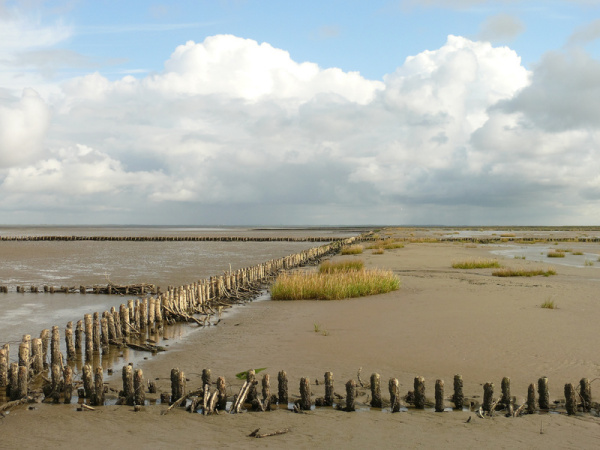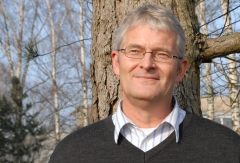Sustainable use of the North Sea and the Baltic Sea: coastal researchers provide the basis for future protection of the marine environment.
In the course of the next 3 years, coastal researchers at the Helmholtz-Zentrum Geesthacht will examine the influence of human activities on the sea floor in the German Bight. Their work, which will be carried out in five collaborative projects, is part of a comprehensive evaluation of the state of the coastal sea floors in the North Sea and the Baltic Sea. This venture is funded by the Bundesministerium für Bildung und Forschung BMBF (Federal Ministry of Education and Research) and will provide a scientific basis for the implementation of the European Marine Strategy Framework Directive. On the 29th of April representatives of the BMBF and participants in the projects will meet at the University of Hamburg, KlimaCampus to launch this collaborative research effort.

Sediments in the Wadden Sea and seafloors of the North Sea coast have many functions within the marine ecosystem. For example, the sediments filter pollutants out of the water. Photo: Matthias Creydt, Fotolia
The sea floor is not only a habitat for organisms but fulfils many functions within the ecosystem – for example, sediments filter pollutants out of the water.
In order to determine these functions and assess the state of the sea floor, coastal researchers of the Helmholtz-Zentrum Geesthacht, working in cooperation with other scientists, will closely examine the processes which take place within the seabed and determine its interaction with the overlying water.
The investigations are at the focus of the project “North Sea Observation and Assessment of Habitats” (NOAH). NOAH is one of five collaborative projects supported by the BMBF which were set up in the scope of KüNo, Küstenforschungsagenda für Nord- und Ostsee (Coastal Research Agenda for the North and Baltic Seas) and which are now commencing their work.
The aim of the projects: a better understanding of the sea floor status, its interactions with ecosystems in the coastal regions, and an assessment of possible future changes and risks.
Investigations into the state of the sea floor

Photo: HZG
One aim of the coastal researchers is to specify indicators for the environmental state of the sea floor which reacts sensitively to human influences.
As Prof. Dr. Kay Emeis, one of the heads of the Institute of Coastal Research at the Helmholtz-Zentrum Geesthacht and coordinator of the NOAH collaborative project, explains: “With the help of indicators we can draw conclusions about the state of the sea floor as an important component of the entire ecosystem.
For example, certain bacteria in the sea floor convert the nitrate, which is responsible for the increase in algae production, into nitrogen. However, this service provided by the ecosystem only occurs in natural sediments. Pristine sea floors are becoming rare, for example in the tidal Elbe”.
The scientists plan to compile a Habitat Atlas for the German Bight, using the NOAH results. Within the first project year, the Atlas will depict the contamination of the sea floor with pollutants. The long-term intention of the Atlas is to inventory sediment types and ecosystem functions, recognise and map the effects of human influences, such as the fishing industry or offshore wind farms, and provide data permitting to better define good environmental status of the sea floor.
Research results for wider use
To make results of research accessible and useful to institutional and public stakeholders, a joint infrastructure is being established by all collaborative projects for publication, utilisation and sustained archiving of the research data.
One of the five collaborative projects, “Modular System for Shelves and Coasts” (MOSSCO), will construct a cross-project modular computer model platform.
Much as in a building block system, physical chemical, biological and geological modules can be flexibly combined to meet specific requirements for ecosystem model simulations. This modular system will enable a more comprehensive understanding of interrelationships in the coastal regions and promote the transfer of knowledge to the application by means of an appropriate user interface - as the fields of politics, science, commerce and associations need to jointly implement the Marine Strategy Framework Directive.
Invitation to journalists to join round table talks
The KüNO Kickoff Meeting will take place on the 29th of April on the KlimaCampus of the University of Hamburg. Prof. Dr. Kay Emeis (Helmholtz-Zentrum Geesthacht), Prof. Dr. Ulrich Bathmann (Leibnitz Institut für Ostseeforschung – Leibnitz Institute for Baltic Sea Research) and Dr. Gerd Kraus (Thünen-Institut für Seefischerei – Thünen Institute of Sea Fisheries) invite journalists to round table talks which will commence at 12:45 o’clock. Please notify Julika Doerffer in advance, if you wish to attend.
Background
The European Marine Strategy Framework Directive stipulates that a good environmental status of the marine environment is to be achieved by 2020 and enduringly conserved in all member countries of the European Union. In the next three years, the Bundesministerium für Bildung und Forschung BMBF (Federal Ministry of Education and Research) is supporting basic research under the “Coastal Research Agenda for the North and Baltic Seas” (KüNO) with a total funding of 6 million euro. Five collaborative projects have been set up for this purpose with the aims to define a good state of the sea floor in Germany’s Exclusive Economic Zone in the North Sea and Baltic Sea, and create a scientific knowledge base that aids to achieve and maintain this status.
Partners in the NOAH collaborative project, coordinated at the Helmholtz-Zentrum Geesthacht, are the Bundesamt für Seeschifffahrt und Hydrographie (Federal Maritime and Hydrographic Agency), the Thünen-Institut für Seefischerei (Thünen Sea Fisheries Institute), the Alfred Wegener-Institut Helmholtz-Zentrum für Polar- und Meeresforschung (Centre for Polar and Maritime Research), Senckenberg am Meer, and university groups from the Zentrum für Marine Umweltwissenschaften der Universität Bremen (Centre for Marine Environmental Sciences of the University of Bremen), the Centrum für Erdsystemforschung und Nachhaltigkeit (CEN) (Centre for Earth System Research and Sustainability ) of the University of Hamburg, and the Hochschule für Angewandte Wissenschaften Hamburg (Hamburg University of Applied Science).
The projects are embedded in the BMBF framework programme “Forschung für nachhaltige Entwicklung” , FONA (Research for Sustainable Development). The Jülich Research Centre is responsible for the project management of the KüNO Research Association.
Further information
Information on the Marine Strategy Framework Directive of the Federal Agency for Nature Conservation (Bundesamt für Naturschutz) To the Coastal Research Agenda for the North Sea and Baltic Sea To the Institute of Coastal Research at the Helmholtz-Zentrum Geesthacht To the KlimaCampus at the University of Hamburg
